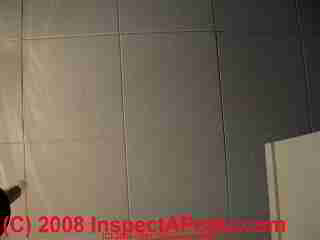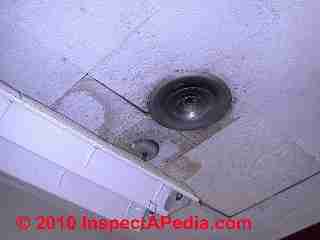 Asbestos in Boise Cascade Ceiling Tiles ?
Asbestos in Boise Cascade Ceiling Tiles ?
Do some Boise Cascade ceiling tiles contain asbestos?
- POST a QUESTION or COMMENT about how to identify ceiling tiles that contain asbestos
Some sources assert that some Armstrong brand ceiling tiles may contain asbestos:
In this article series we discuss how to recognize & handle ceiling tiles that may contain asbestos.
We describe the appearance, ingredients, years of manufacture, history, and producers of various types of ceiling tiles & coverings as an aid in determining whether or not a particular ceiling covering or tile is likely to contain asbestos.
InspectAPedia tolerates no conflicts of interest. We have no relationship with advertisers, products, or services discussed at this website.
- Daniel Friedman, Publisher/Editor/Author - See WHO ARE WE?
Do Boise Cascade Ceiling Tiles Contain Asbestos?

Question: Boise Cascade Winterfe? Ceiling Tiles 12,12" from 1971
In 1976 I became the 3rd occupant of a mid-1920s constructed bungalow style house.
The dining room & living room had ceiling tiles installed over plaster and lath in 1971. I have an original product box with several unused leftover tiles.
The tiles were produced by Boise Cascade.
The portion of the tiles’ name is missing; it is
Winterfe__, Decorator Tile, 23222, ½” x 12” x 12”, 64 sq. ft. 64 pcs., Green and White, Flanged T & G Joint.
- Anonymous by private email 2017/09/11
Reply:
Asbestos was used in some building products sold by Boise Cascade, though its principal product ingredient was cellulose - wood or wood fibre. A Boise Cascade paper mill in Boise Idaho is listed by some sources (typically mesothelioma lawyer websites) as a jobsite where employees were likely to have been exposed to asbestos materials.
The company's asbestos products included gaskets and asbestos sheets used in a variety of applications. Even if a product were intended to be 100% wood fibre, **IF** it was produced in the same plant or same site where asbestos was stored, handled, or used, it might be possible that there was some asbestos particle or dust cross-contamination.
For this reason I expect that few people would provide a guarantee that such products are absolutely asbestos free, even if the probability of an actual hazard is close to nil.
I'm left having to suggest that if you have to make a dusty demolition of suspect material it's worth the $40. or $50. to have a lab test a representative sample of the material.
See ASBESTOS TESTING LAB LIST if you need to take that step, and if you do, please keep me informed as what you learn will help others.
(Mar 25, 2017) Don said: Asbestos in Boise Cascade Insulite Ceiling Tile,?
I have a home with a type of fiber ceiling tiles in it, I recently found a leftover box of the tiles stored in a garage attic.
The box is Boise Cascade Insulite Ceiling Tile, the paperwork/ instructions in the box were printed in 1967, any idea as to the composition of these tiles?
Thanks, Don
Reply:
Don
I don't know, Please use the page top or bottom contact link to send me some sharp photos of the ceiling tiles (both sides) and all sides of the box itself - I'll research the question regardless but the photos would be most-helpful.
Asbestos was used in some building products sold by Boise Cascade, though its principal product ingredient was cellulose - wood or wood fibre.
Insulite was a registered trademark of the Boise Cascade Corporation registered in 1975. The name "Insulite" has a much longer history, appearing in patents as early as 1920 - the Insulite Co. Wall Construction, who produced wallboard out of fibrous waste material. The word "Asbestos" does not appear in the patent disclosures that I reviewed.
- Downing, John G. "Knockdown display." U.S. Patent 3,571,999, issued March 23, 1971.
- French Jack W, Heffley Howard H, Lewanski Richard M, Modry Richard E, "Curtain coating apparatus." U.S. Patent 3,404,658, issued October 8, 1968.
The description provided to the US Patent Office for for "insulite" was primed siding; soffit-facia system-namely, soffit-facia panels and metal accessories, for use in house cornice and rake sections; acoustical ceiling tile;
decorator ceiling tile; grid ceiling panels; luminous and grilled vent grid ceiling panels;
mineral acoustical tile and grid ceiling panels; suspended grid and fire-rated grid ceiling systems comprising panels, framing members and supporting members therefore;
sound deadening board; vinyl coated siding; colored siding; and textured siding.
I'm researching the company's Celotine mineral fiber ceiling tiles, so far with no indication that the company produced a product with that name.
Comments:
(Mar 13, 2015) Sergio Freddson said:
This is a very thorough article! I never realized asbestos was so common in residential homes. I guess I just always assumed it was used more often in commercial buildings. I'll have to double check a few areas in my home for asbestos tiles. Thank you for your advice!
Reply:
Generally asbestos-containing materials such as ceiling tiles are safest left alone and in-place unless the material is damaged, falling down, shedding, leaving debris that can be tracked through a home or otherwise made airborne.
It's ok to paint over, encapsulate, seal, or cover-over such materials if occupants prefer. Unnecessary removal is actually more likely to be hazardous than leaving the material alone.
...
Continue reading at ASBESTOS CEILING TILE REMOVAL PROCEDURES or select a topic from the closely-related articles below, or see the complete ARTICLE INDEX.
Or see these
Recommended Articles
- ASBESTOS CEILING TILE IDENTIFICATION
- CEILING TILE HISTORY / DATES - asbestos ceiling tile history & Dates
- CEILING TILE MANUFACTURER ID
- CEILING TILE INGREDIENTS
- CEILING TILE REMOVAL PROCEDURES
- CEILINGS, DROP or SUSPENDED PANEL
- ASBESTOS CEILING TILE IDENTIFICATION - 5 Easy Steps to tell if CEILING TILES are likely to contain asbestos
- ASBESTOS CEILING TILE ID REQUESTS
- ASBESTOS CEILING TILE REMOVAL PROCEDURES
- ASBESTOS-FREE CEILING TILES
- ASBESTOS-SUSPECT CEILING COVEROVER
- ASBESTOS TESTING LAB LIST - certified asbestos testing labs
Suggested citation for this web page
BOISE CASCADE CEILING TILES at InspectApedia.com - online encyclopedia of building & environmental inspection, testing, diagnosis, repair, & problem prevention advice.
Or see this
INDEX to RELATED ARTICLES: ARTICLE INDEX to ASBESTOS HAZARDS
Or use the SEARCH BOX found below to Ask a Question or Search InspectApedia
Ask a Question or Search InspectApedia
Try the search box just below, or if you prefer, post a question or comment in the Comments box below and we will respond promptly.
Search the InspectApedia website
Note: appearance of your Comment below may be delayed: if your comment contains an image, photograph, web link, or text that looks to the software as if it might be a web link, your posting will appear after it has been approved by a moderator. Apologies for the delay.
Only one image can be added per comment but you can post as many comments, and therefore images, as you like.
You will not receive a notification when a response to your question has been posted.
Please bookmark this page to make it easy for you to check back for our response.
Comments
IF above you see "Comment Form is loading comments..." then COMMENT BOX - countable.ca / bawkbox.com IS NOT WORKING.
In any case you are welcome to send an email directly to us at InspectApedia.com at editor@inspectApedia.com
We'll reply to you directly. Please help us help you by noting, in your email, the URL of the InspectApedia page where you wanted to comment.
Citations & References
In addition to any citations in the article above, a full list is available on request.
- .../li>
CONTINUE READING or RECOMMENDED ARTICLES.
- Carson, Dunlop & Associates Ltd., 120 Carlton Street Suite 407, Toronto ON M5A 4K2. Tel: (416) 964-9415 1-800-268-7070 Email: info@carsondunlop.com. Alan Carson is a past president of ASHI, the American Society of Home Inspectors.
Thanks to Alan Carson and Bob Dunlop, for permission for InspectAPedia to use text excerpts from The HOME REFERENCE BOOK - the Encyclopedia of Homes and to use illustrations from The ILLUSTRATED HOME .
Carson Dunlop Associates provides extensive home inspection education and report writing material. In gratitude we provide links to tsome Carson Dunlop Associates products and services.


No one has commented yet. Be the first!